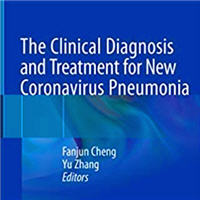Tag: pneumonia
HSV-1 Reactivation Associated with Increased Mortality Risk and Pneumonia in COVID-19 Patients
Critically ill COVID-19 patients frequently reactivate HSV-1 but not HSV-2. HSV-1 reactivation in critically ill COVID-19 patients was associated with an increased risk of day-60 mortality and hospital-acquired pneumonia... read more
The Clinical Diagnosis and Treatment for New Coronavirus Pneumonia
This book is a practical manual for anti-COVID-19. It is not only with the reference to the result of modern medical science, patients' situation, but also take the deployment of medical resources into consideration. Content... read more

Effect of High vs. Low Dose of Dexamethasone on COVID-19 Pneumonia Patients
Among hospitalised COVID-19 patients needing oxygen therapy, high dose of dexamethasone reduced clinical worsening within 11 days after randomisation as compared with low dose of dexamethasone. Further studies are necessary... read more
ARDS and High Blood Endocan Profile During COVID‑19
With great interest, we read the recently published paper by Pascreau et al. concluding that a high blood endocan profile during COVID‑19 distinguishes moderate from severe acute respiratory distress syndrome (ARDS). In... read more
Procalcitonin-guided Antibiotic Treatment Effect on Mortality in Acute Respiratory Infections
Use of procalcitonin to guide antibiotic treatment in patients with acute respiratory infections reduces antibiotic exposure and side-effects, and improves survival. Widespread implementation of procalcitonin protocols... read more
miR-221-5p-Mediated Downregulation of JNK2 Aggravates ALI
Sepsis and acute lung injury (ALI) are linked to mitochondrial dysfunction; however, the underlying mechanism remains elusive. We previously reported that c-Jun N-terminal protein kinase 2 (JNK2) promotes stress-induced mitophagy... read more
Metabolomic Diferences: COVID-19 vs. H1N1 Influenza in ARDS
This study aimed to compare the specificity of the metabolic alterations induced by COVID-19 or Influenza A pneumonia (IAP) in acute respiratory distress syndrome (ARDS). Our findings support the concept that ARDS is associated... read more
Rapidly Progressive Brain Atrophy in Septic ICU Patients
Many ICU patients with severe sepsis who developed prolonged mental status changes and neurological sequelae showed signs of brain atrophy. Patients with rapidly progressive brain atrophy were more likely to have required... read more
Oxygenation Responses Mechanisms to Proning and Recruitment in COVID-19 Pneumonia
In unresolving COVID-19 pneumonia, the respiratory mechanics and the gas-exchange response to prone positioning and recruitment largely depend on the following two factors: perfusion dysregulation and the amount of consolidated... read more
Acute Eosinophilic Pneumonia Secondary to Daptomycin
Daptomycin is an antimicrobial agent with activity against gram-positive bacteria that is usually reserved for severe infections. Acute eosinophilic pneumonia (AEP) is an increasingly rare side effect that can manifest after... read more
Carbapenem Antibiotics for the Empiric Treatment of Nosocomial Pneumonia
Carbapenem-based empiric regimens were associated with lower mortality rates compared with non-carbapenems, largely driven by trials of ventilator-associated pneumonia (VAP). The mortality effect was not observed in trials... read more
Continuous Pneumatic Regulation of Tracheal Cuff Pressure to Decrease VAP in Mechanically Ventilated Patients
Continuous regulation of cuff pressure of the tracheal tube using a pneumatic device was not superior to routine care in preventing Ventilator-associated pneumonia (VAP) in patients with severe trauma. A total of 434 patients... read more
Fungal Infections Complicating COVID-19
Coronavirus disease 2019 (COVID-19), caused by the severe acute respiratory syndrome coronavirus 2 (SARS-CoV-2), spread globally to pandemic proportions. Although the majority of cases have asymptomatic or mild infections,... read more

Incidence of Arrhythmia Higher in COVID-19 vs. Other CAPs
The incidence of arrhythmia was higher in COVID-19 than in other community-acquired pneumonia (CAP), with 2 out of 10 COVID-19 patients dying after developing arrhythmia. Higher incidence rates of conduction disorders... read more
Effects of Early Mobilization on the Prognosis of Critically Ill Patients
Early mobilization was effective in enhancing the recovery of critically ill patients, but more large-scale, multicenter randomized controlled trials are required to further confirm these findings. A total of 39 articles... read more
Thrombosis vs. Hemorrhage Rates in Patients with Severe Respiratory Failure Due to COVID-19
Significant rates of pulmonary thromboembolism and of catheter-associated deep vein thrombosis were seen in both viral infections but were greater in those requiring the use of extracorporeal membrane oxygenation in coronavirus... read more
Non-invasive Respiratory Support and P-SILI in COVID-19
Coronavirus disease 2019 (COVID-19) pneumonia is associated with hypoxemic respiratory failure, ranging from mild to severe. Due to the worldwide shortage of intensive care unit beds, a relatively high number of patients... read more
The Clinical Utility of MRSA Nasal Screening to Rule Out MRSA Pneumonia
Nares screening for methicillin-resistant Staphylococcus aureus (MRSA) had a high specificity and NPV for ruling out MRSA pneumonia, particularly in cases of CAP/HCAP. Based on the NPV, MRSA nares screening is a valuable... read more
POCUS of the Heart and Lungs in Patients with Respiratory Failure
Point-of-care ultrasound (POCUS) is a focus oriented tool for differentiating among cardiopulmonary diseases. Its value in the hands of emergency physicians, with various ultrasound experience, remains uncertain. We tested... read more
Host Endothelial, Epithelial and Inflammatory Response in ICU COVID-19 Patients
These studies demonstrate that, unlike other well-studied causes of critical illness, endothelial dysfunction may not be characteristic of severe COVID-19 early after ICU admission. Pathways resulting in elaboration of acute... read more
Validation of Sputum Gram Stain for Treatment of CAP and HCAP
The usefulness of sputum Gram stain in patients with community-acquired pneumonia (CAP) is controversial. There has been no study to evaluate the diagnostic value of this method in patients with healthcare-associated pneumonia... read more
Post‑COVID‑19 Syndrome in Outpatients
Background Some patients experience long-term symptoms after COVID-19, but data on outpatients with mild-to-moderate COVID-19 are scarce. Objective To describe persisting symptoms more than 3 months after infection in PCR-confirmed... read more









